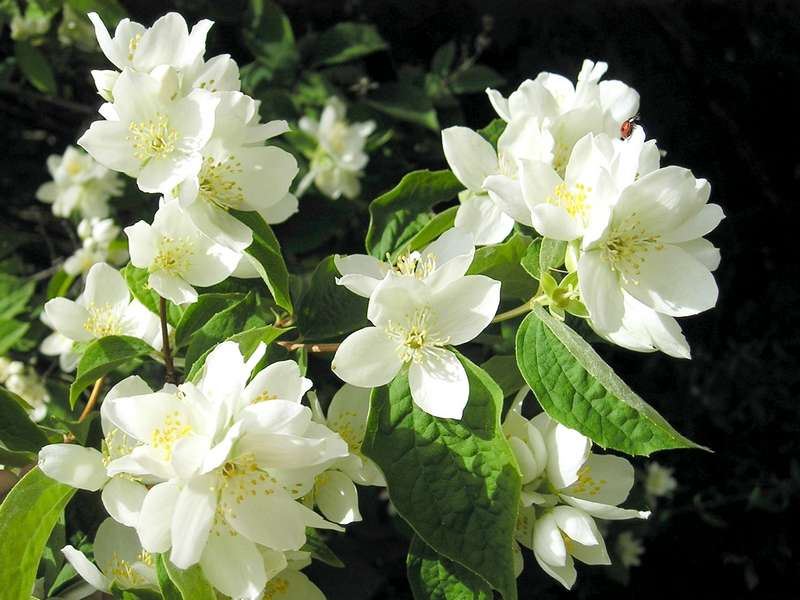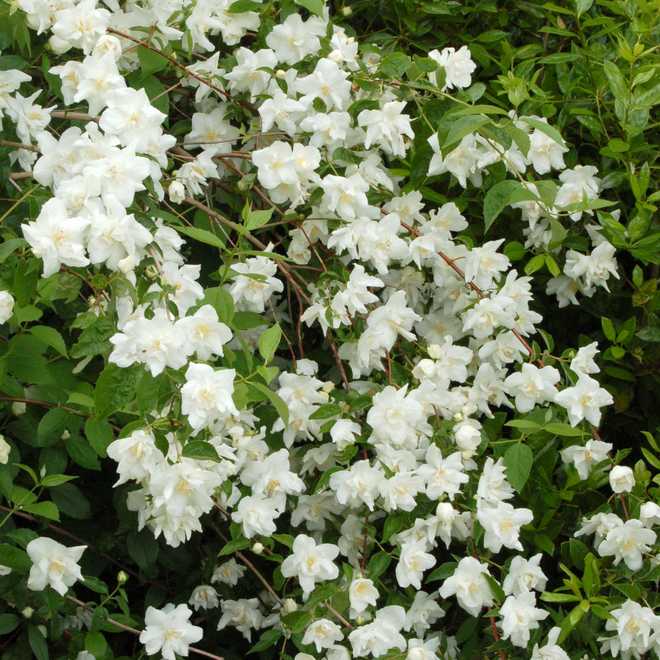
The mock orange ( Philadelphus ) has long been appreciated in gardens for the delicate fragrance of its flowering, comparable to orange blossom, and for the dazzling whiteness in May-June of its flowers.
A wide variety of syringes
There are a large number of mock oranges , including many hybrids from North America or Asia, all very hardy and undemanding as to the nature of the soil. Dwarf varieties ( seringat virginal ) with a compact and rounded habit (80 cm to 1 m high) alongside large varieties (2.50 to 3 m) lending themselves more to planting in isolation or in a free and flowering hedge for form small groves.
The beautiful starry flowers of the mock orange , always white, single or double depending on the variety, bloom in May-June on secondary branches. They sometimes display a red-purple heart and almost always exhale a discreet or more powerful fragrance.
The foliage, simple, is obsolete. Of a beautiful deep green in summer, the oval and slightly toothed leaves of the shrub take on a beautiful yellow color in the fall if the location is sunny.
Where to grow it?
Rustic and easy to cultivate, the seringat likes all soils that remain cool, even limestone. On the other hand, it fears heavy and waterlogged soils. Drought resistant, it tolerates lack of water in summer but blooms best if the soil remains cool.
Plant it in the sun and sheltered from drafts so that it blooms in abundance. Mulch his feet to keep freshness.
Cut the mock orange
If your seringat is still young, after spring flowering in June, cut back the length of the branches that have flowered by a third. Regular pruning in the early years helps maintain a compact habit and prevents the shrub from thinning out at the base.
If your mock orange is older, perform this pruning every two years. Complete it by removing one or two very old branches and excess branches that cross inside the shrub to increase the amount of flowering.
If you want to rejuvenate a seringat virginal left without maintenance for a few years, coppice the shrub: it supports it well.
What shrubs to associate with it?
The white color of the flowers of the seringat virginal goes very well with many colors. In a medium-sized free hedge, combine, for example, the varieties that flower in May with Photinia, whose red color of the young leaves is resplendent.
Don’t hesitate either to combine mock oranges with non-remontant roses with pink flowers to obtain a delicate and romantic marriage. Complete the picture by planting spring bulbs (hyacinths, tulips) at their feet.
Mock orange, Philadelphus coronarius
Naturally present from Italy to the Caucasus, it is likely that the garden mock orange has been cultivated by the hand of man for as long as he appreciates the art of gardening. The garden mock orange tolerates the driest soils. Its single, double or semi-double flowers depending on the cultivar, give off a heady fragrance, one of the most powerful of the Philadelphus genus.
The shrub reaches 3 in height and develops a somewhat stiff habit which makes it suitable for voluminous hedges. Some of its long branches covered with bright green oval leaves hang down gracefully.
Natchez’s grin
The major assets of the Natchez virginal mock orange : the remarkable white color of its large single flowers and abundant flowering that lasts longer than that of other mock oranges. But the scent of these flowers is more discreet.

The dark green, shiny leaves are also very beautiful and provide a beautiful setting for its bright flowering.
This shrub develops a compact and rounded port (1m to 1m50 high)
Mock orange Belle star
This generous variety, 1.5 m to 2 m high, develops an erect habit. Its simple, white flowers bloom in early summer (June-July) and reveal a discreet pink to purple spot at the base of the petals, in the center. They are wonderfully scented.
Mock Orange Coat of Ermine
Its white, double flowers bloom in clusters in May-June, exhaling a delicate fragrance. This seringat virgina l forms a compact shrub, almost wider than it is tall (1m high, 1.5m wide)
Shit Silberregen
Close to Mantle of Ermine, this equally compact and rounded virginal mock orange (1m in all directions) is covered with many simple white flowers which give off a sweet scent in June-July with hints of strawberry. Due to the abundance of its flowering, the English gave it the poetic nickname of “Silver shower”.
Syringa et seringat
Syringa and mock orange should not be confused . The Latin name of Syringa was that of the mock orange before the botanist Linnaeus transferred it to the lilacs and decided in exchange to give the mock orange the name Philadelphus.
Too bad he did not take into account the use made of the plant: the mock orange was indeed called syringa partly because of its stems which, once emptied of their marrow, were used to make syringes.
